LG G2 and MSM8974 Snapdragon 800 - Mini Review
by Brian Klug on September 7, 2013 1:11 AM EST- Posted in
- Smartphones
- LG
- Mobile
- LG G2
- Android 4.2
- MSM8974
- Snapdragon 800
CPU Performance
LG's G2 features a quad-core Snapdragon 800 SoC (MSM8974). For a quick refresher, Snapdragon 800 features four Krait 400 cores running at up to 2.3GHz courtesy of TSMC's 28nm HPM process. The 2.3GHz max clock speed comes at a surprisingly low voltage thanks to the low power HPM process. Gone are the days of 1.4V to hit near-2GHz frequencies it seems, instead 8974 will hit 2.3 GHz at around 1V. Krait 400 improves L2 access latencies over Krait 300 (which is at the heart of Snapdragon 600 and S4 Pro) and is optimized for higher frequency operation, but Krait 400 is otherwise architecturally similar to Krait 300. Make no mistake, MSM8974 is the new high-end, pushing Snapdragon 600 and S4 Pro parts further down into midrange category. There are other SoC level enhancements as well, including things like a new version of the Hexagon DSP and obviously Adreno 330 vs. Adreno 320 (which I'll get to later). We already ran through a performance preview of Snapdragon 800/MSM8974 using Qualcomm's 8974 Tablet Mobile Development Platform, but today we get to do the same with the G2.
LG was pretty eager to get us a G2 sample as early as possible, unfortunately that comes at the expense of software maturity. LG made it very clear to us that the International G2 sample (LG-D802) we received has nowhere near final software, and as a result may not deliver performance indicative of what we'll see when the device shows up later this month. This puts us in an interesting situation as we want to see how close shipping Snapdragon 800 devices come to the Snapdragon MDP/T we tested back in June. Software maturity aside, there's no skirting the fact that the G2 simply has a smaller chassis and perhaps lower thermal limits than the tablet MSM8974 MDP/T we tested previously.
The most interesting comparison points here will be to LG's Optimus G Pro which ships with a Snapdragon 600 (4 x Krait 300 running at 1.7GHz), the Exynos 5 Octa based Galaxy S 4 (SHVE300S) and to the MDP/T. As always, we'll start with a look at CPU performance.
The state of CPU performance testing under Android is unfortunately still quite broken. We're using a mix of browser based tests with Java & Native apps (AndEBench).
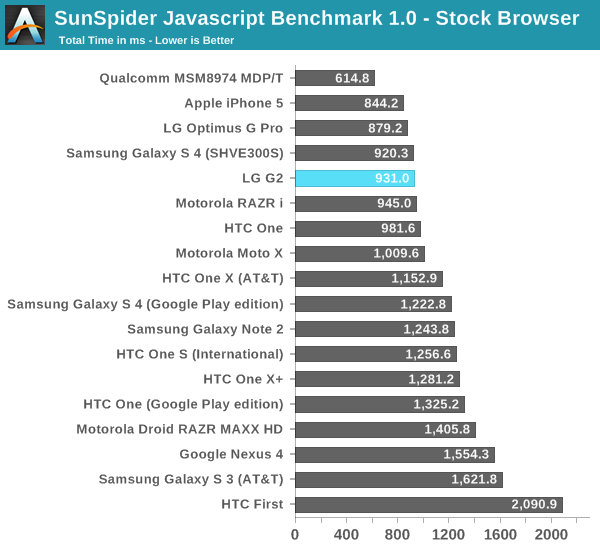
SunSpider has quickly become an exercise in browser optimization rather than platform performance. Qualcomm's browser optimizations are clearly good for showing off Snapdragon 800's potential, however the G2 doesn't appear to have the same optimizations in place (yet). Performance isn't bad, but it's merely on par with Snapdragon 600 and ARM's Cortex A15.
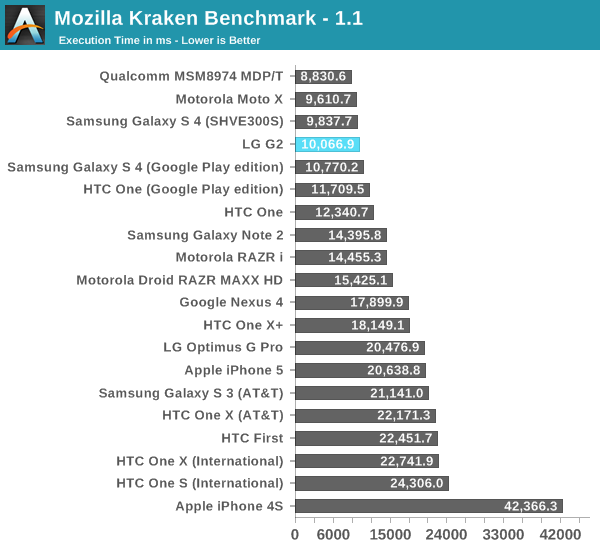
Kraken is an interesting test as it has (thus far) remained less of a browser optimization target. Kraken is also a physically larger and longer benchmark, which provides results that I tend to be a little happier with. The G2 once again falls short of Qualcomm's MDP/T, but given its early software I'm not too surprised. Performance is roughly on par with the Exynos 5 Octa, and slightly behind the very high clocked Snapdragon 600 in the nearly stock Moto X.
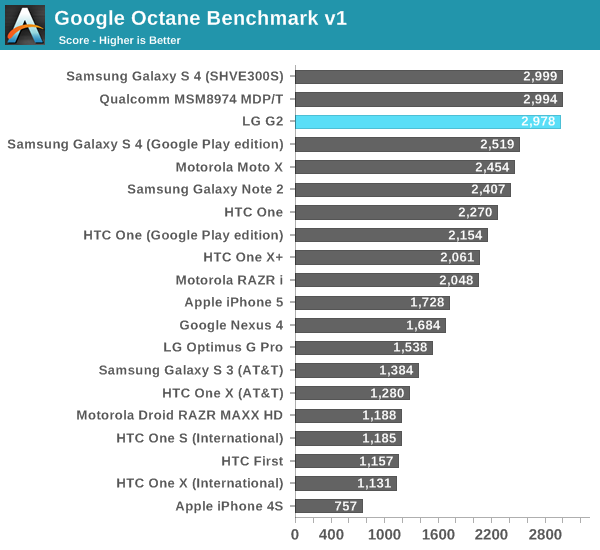
Octane is the first benchmark where we see the Snapdragon 800 flex its potential. Here the G2 not only ties the Snapdragon 800 MDP/T, but it also roughly equals the performance of the Cortex A15 based Exynos 5 Octa. Ultimately that's the comparison that Qualcomm will be most interested in winning. If Snapdragon 800 can deliver better performance (or at least perf per watt) than the Cortex A15, it'll be a definite win for Qualcomm.

If Octane had the S800 in the proverbial passing lane, Browsermark 2.0 shows the G2 in the clear lead. Here LG was able to even outperform Qualcomm's own reference design by 16%. I suspect this has more to do with browser optimizations than anything else though, as the S600 based Optimus G Pro also does extremely well.
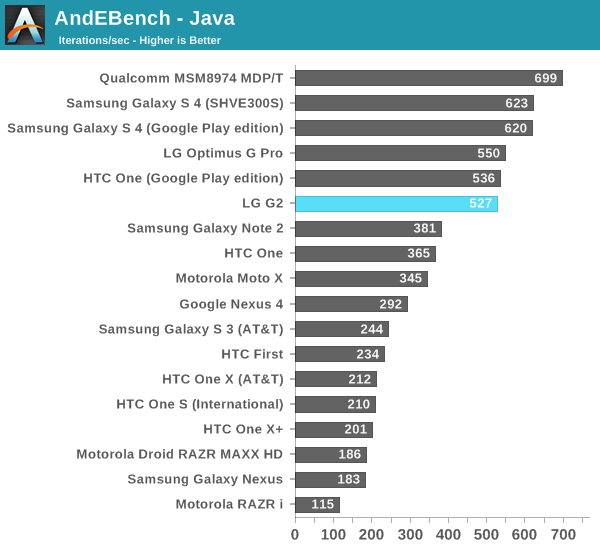

AndEBench provides us with very low level look at SoC performance. I'm not a huge fan of these types of tests, especially ones that aggregate a bunch of microbenchmarks and attempt to present a single performance number. AndEBench is unique (and useful) in that it presents performance in both native code and Dalvik interpreted states. The G2's native performance here is quite good, but it's actually equalled by the Galaxy S 4 GPe and not far ahead of the Optimus G Pro. I suspect we're once again seeing the limits of early software rather than a full understanding of Snapdragon 800's performance in a retail device. Dalvik performance is a bit worse. The relatively high ranking of the Google Play Edition devices points to software optimization being a culprit here.
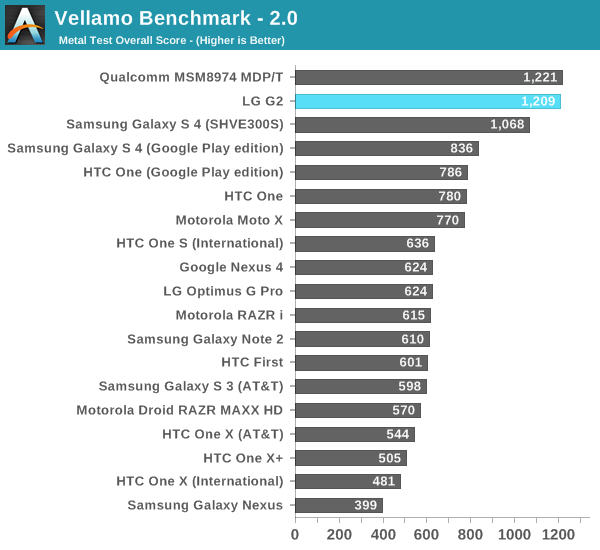
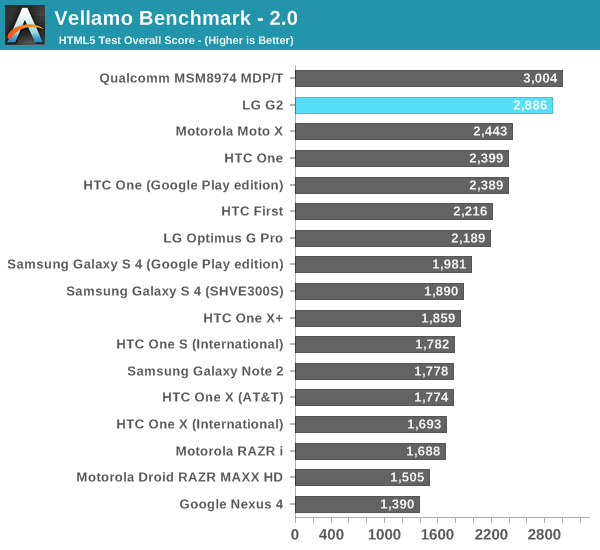
Both Vellamo tests put the G2 on par with Qualcomm's Snapdragon 800 MDP/T.








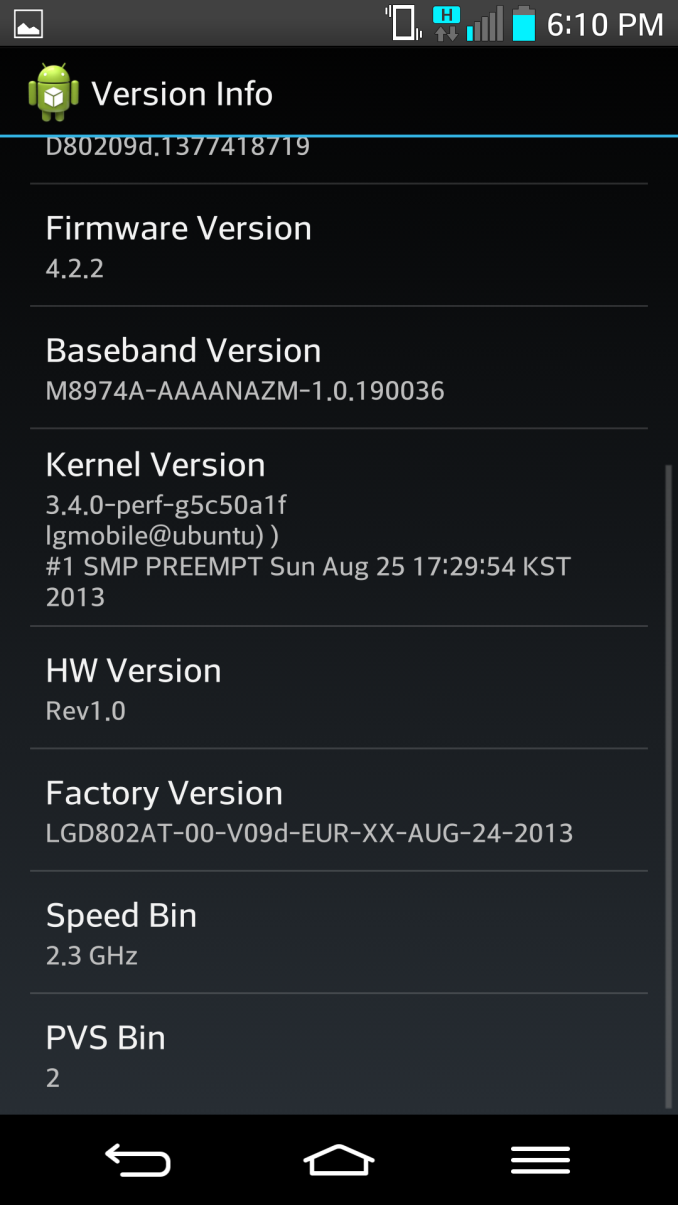
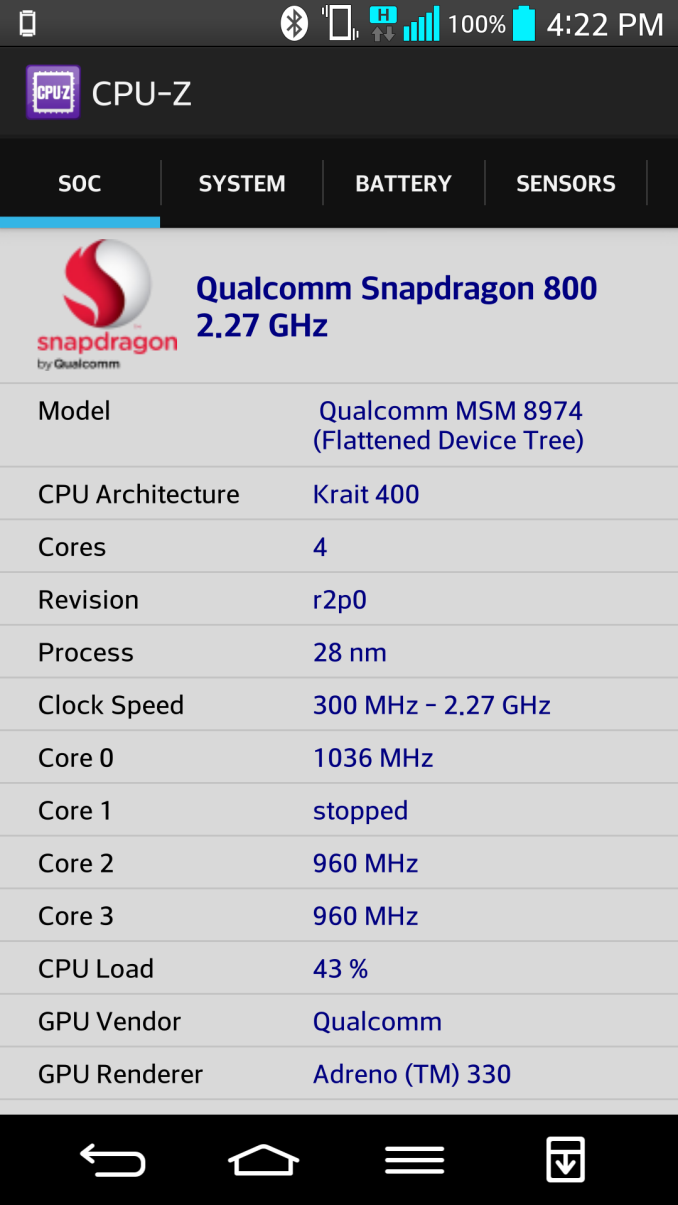








120 Comments
View All Comments
Crono - Saturday, September 7, 2013 - link
I'm surprised this qualifies as a "mini" review (even for AnandTech), but I'm impressed by the graphics performance of the G2 more than anything else. I'm just wondering if there are any applications or games yet that can take advantage on Android.fteoath64 - Saturday, September 7, 2013 - link
The graphics benchmarks put the Moto-X in a strong position een though it uses the older cores and newer Adreno 320 gpu. Granted it has only 1280X720 resolution, the overall performance is very close to the S800 with FullHD screens. This actually means that the Moto-X SoC is well optimized for it purposes. It also seems to beat the SGS4 in most graphics tests.Krysto - Saturday, September 7, 2013 - link
The test was done at 720p - for everyone - which means Moto X is beating most everyone else in GPU performance - at the same resolution. If you take the real world case, and put the others at their native 1080p resolution, then in the real world Moto X will be 2x better in gaming performance since it will push half the pixels.Also Adreno 320 is not new. Is a year old, just like the S4 Pro CPU cores. Just because S4 and HTC One used the same GPU this year, doesn't mean it's "new".
coolhardware - Saturday, September 7, 2013 - link
Pretty nice point!A question though, do any Android games render at a lower resolution and then upscale to fit native resolution?
Also, the LG G2 comes in about 6th place in top pixel density of phones
http://pixensity.com/list/phone/
and it has the largest screen of those top 6 phones... #7 Lenovo / #8 Sony are bigger though :-)
Looking forward to the final review and seeing LTE performance!
nerd1 - Saturday, September 7, 2013 - link
All the pixel density fad is apple's clever ploy to conceal their small screen. Resolution / size = density, so smaller screen will get higher dpi. However, it is quite obvious that if resolution is the same, larger screen is much easier on eye.FwFred - Saturday, September 7, 2013 - link
Agreed, we are well into the point of diminishing returns with PPI on high end smartphones. I'd imagine we are getting to the point where we are wasting power/performance for spec chasing.theduckofdeath - Sunday, September 8, 2013 - link
RR3 doesn't render in 1080p on the GS 4, I can clearly see pixelation in the 3D parts. I guess it might be because they're perhaps lazy in utilizing multi-core hardware? Because the game lags considerably when there are a lot of AI cars in front of you.warisz00r - Saturday, September 7, 2013 - link
If the next Nexus phone is indeed based on this, then color me very stoked.Panickd - Sunday, September 8, 2013 - link
Maybe loosely "based on". According to the FCC paperwork the Nexus 5 has a display of roughly 4.96 inches to the G2's 5.2 inches. Looking at the pictures the camera is also in a different place on both as well. Not huge differences, mind you, but seems like a lot of work going into making them different if they are indeed based on the same general design.I would plunk down for a G2 in a heartbeat if LG didn't have such a shoddy support and update record for their phones. I currently own an old G2x and am currently scanning around for it's successor. I'll have to wait to see what the Nexus 5 really turns out to be, I suppose.
Impulses - Sunday, September 8, 2013 - link
I'd take the smaller display and battery if it comes with a slightly better looking/feeling build (more Moto X and less Galaxy S).